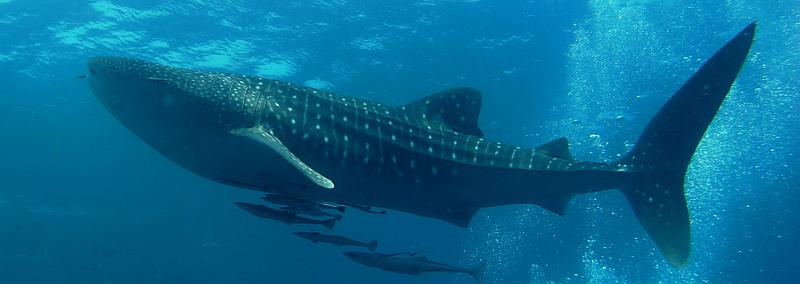 Ship strikes — collisions between ships and large marine life — are a serious threat to whales and other large marine creatures. According to the non-profit Friend of the Sea, ship strikes kill more than 20,000 whales every year.
Ship strikes — collisions between ships and large marine life — are a serious threat to whales and other large marine creatures. According to the non-profit Friend of the Sea, ship strikes kill more than 20,000 whales every year.
Now, new research, published in the Proceeding of the National Academy of Sciences (PNAS), has identified ship strikes as a likely cause for the alarming decrease in the population of the world’s largest fish, the whale shark.
Whale sharks are slow-moving, filter-feeding carpet sharks that can grow up to 70′ long. Whale sharks were declared endangered in 2016. Over the last several decades, more than half of all whale sharks have vanished from the ocean. Some populations have fallen by more than 60 percent.
Vox notes that this decline has been something of a scientific mystery. It can’t be explained by known threats like overfishing. And because whale sharks sink when they die, there aren’t bodies washing up on shore that researchers can study.
“The maritime shipping industry that allows us to source a variety of everyday products from all over the world, may be causing the decline of whale sharks, which are a hugely important species in our oceans,” study co-author and University of Southampton Ph.D. researcher Freya Womersley said in a press release.
To figure out if ship collisions are really a problem for whale sharks, the Global Shark Movement Project, led by the Marine Biological Association (MBA), tracked satellite data covering the movement of nearly 350 whale sharks, the press release explained. Researchers then compared those movements with the movements of shipping fleets large enough to strike and kill a whale shark. What they found was that 92 percent of the whale sharks’ horizontal movements and 50 percent of their vertical movements intersected with shipping traffic, according to the study.
Further, almost a third of the places where whale sharks concentrated were in areas with the highest risk of collision. The scientists also found evidence for accidents. More often than the researchers had predicted, they found that a shark’s last-tracked location was traced to a high-traffic area. This happened more frequently than could be explained by technical failures.
“Incredibly, some of the tags recording depth, as well as location, showed whale sharks moving into shipping lanes and then sinking slowly to the seafloor hundreds of meters below, which is the ’smoking gun’ of a lethal ship strike,” David Sims, MBA senior research fellow, said in the press release. “It is sad to think that many deaths of these incredible animals have occurred globally due to ships without us even knowing to take preventative measures.”
“Collectively we need to put time and energy into developing strategies to protect this endangered species from commercial shipping now, before it is too late, so that the largest fish on Earth can withstand threats that are predicted to intensify in the future, such as changing ocean climates,” Womersley said in the press release.
Thanks to Doug Bostrom for contributing to this post.
